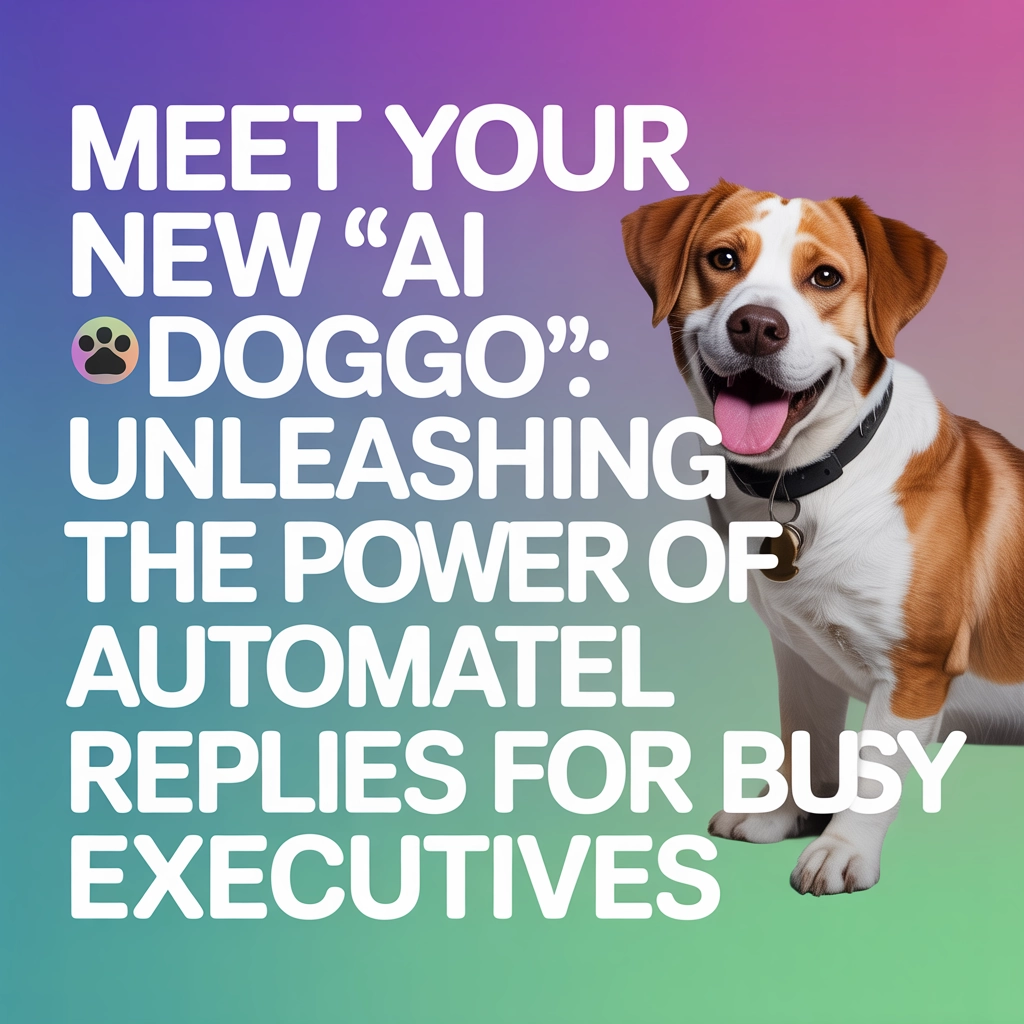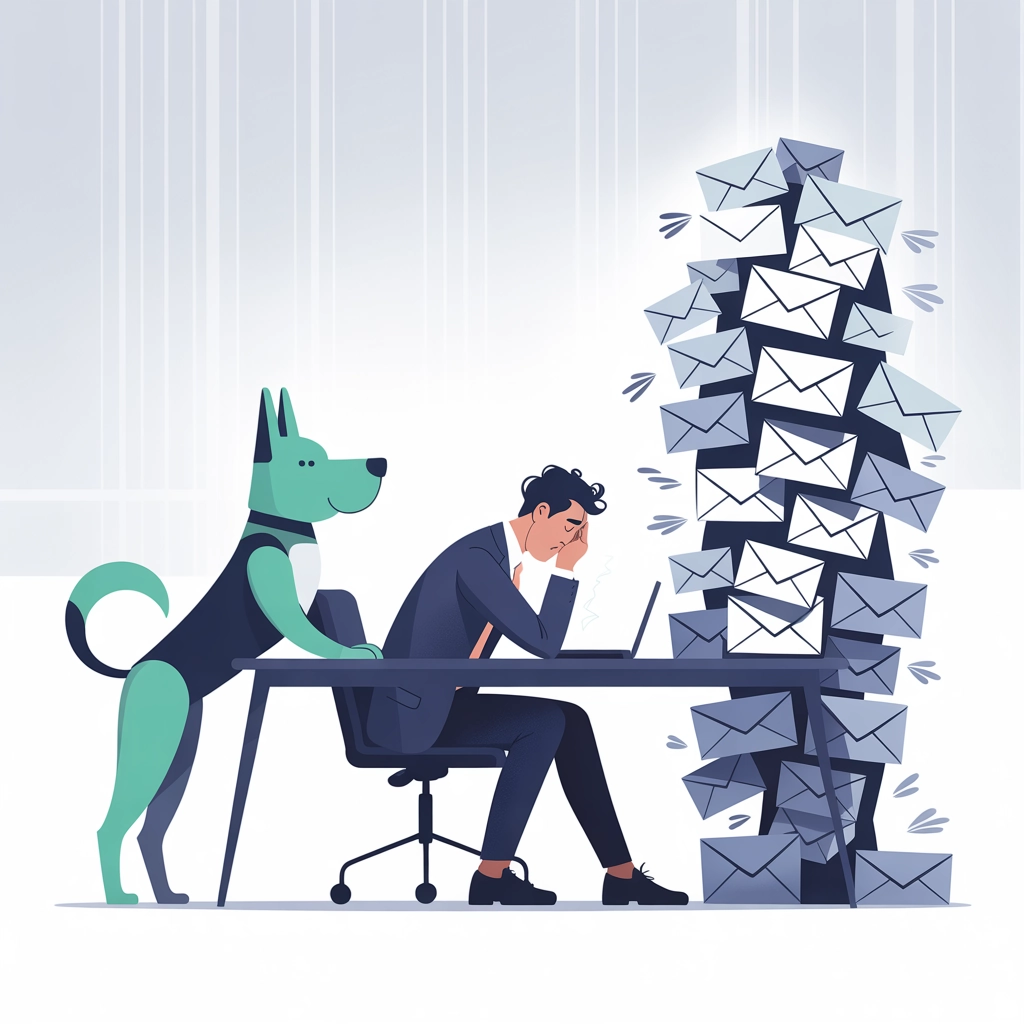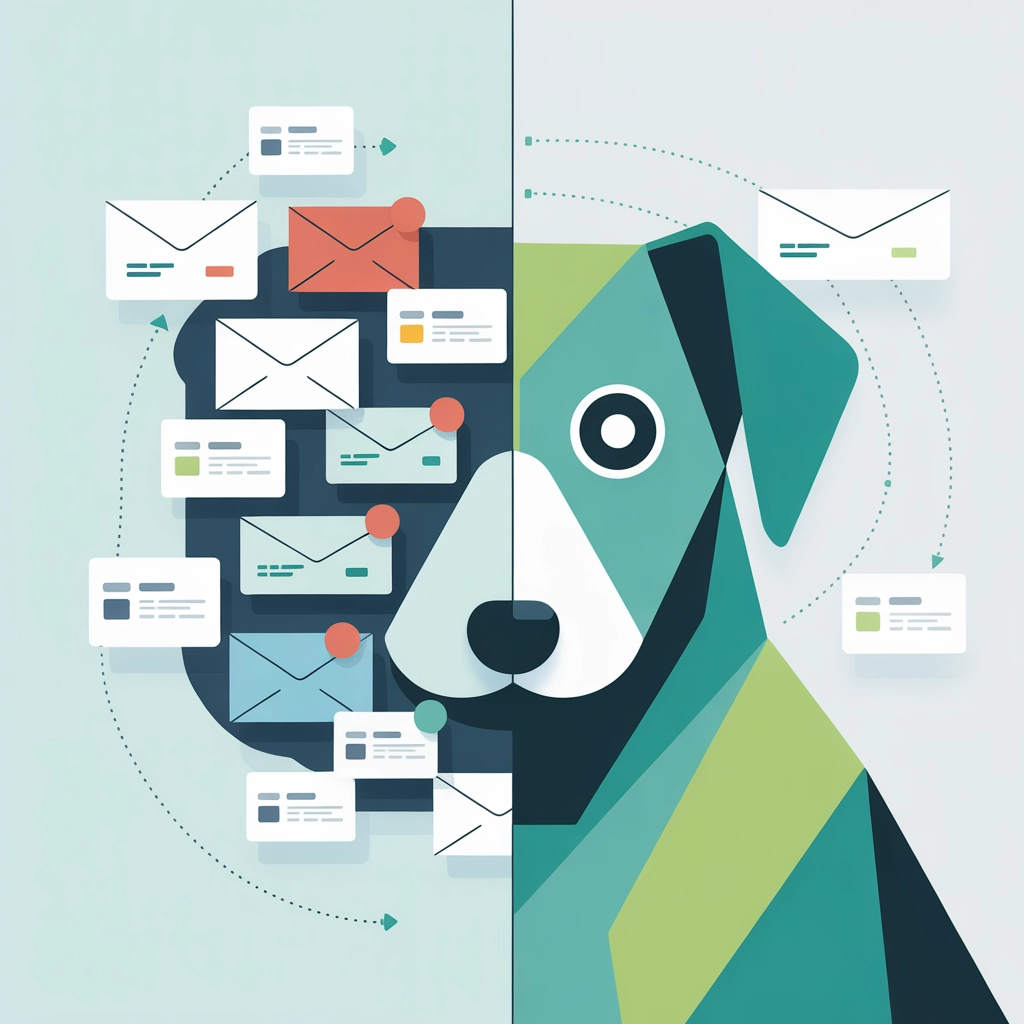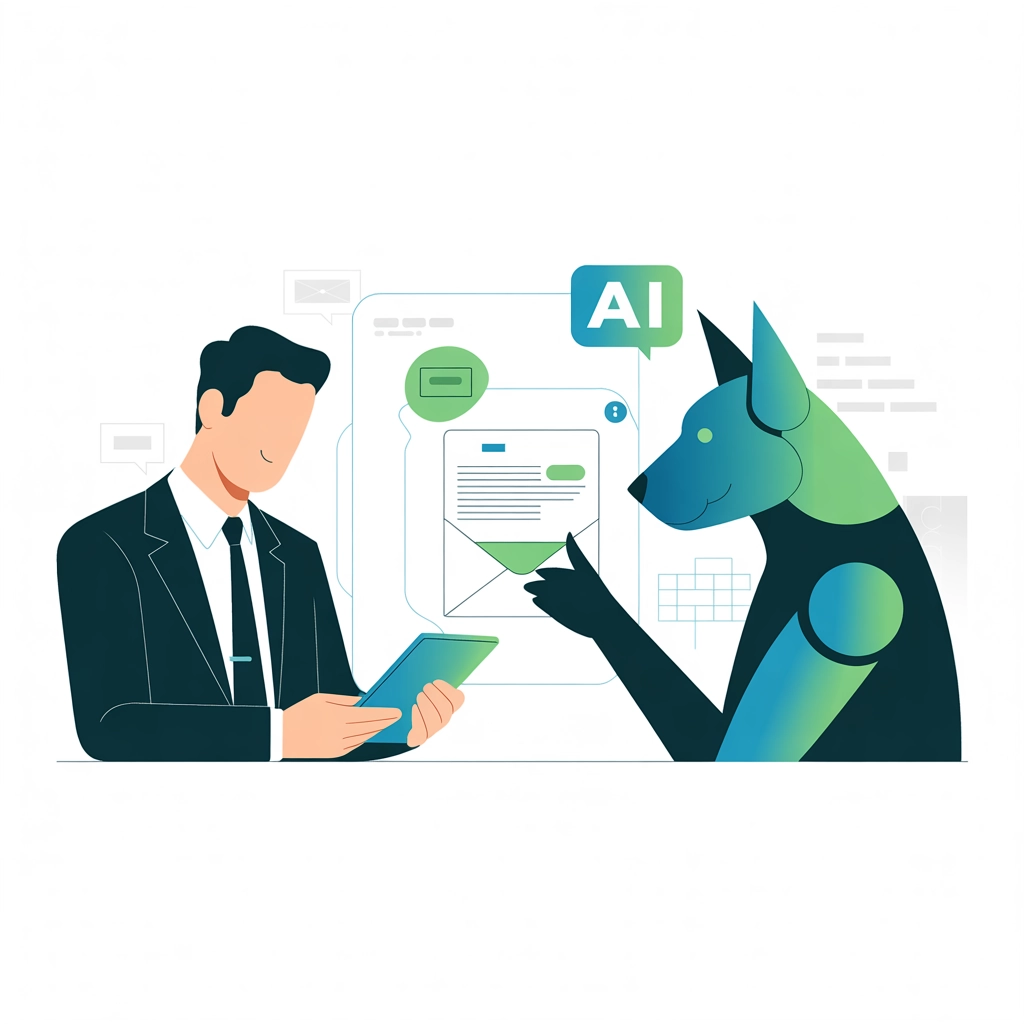Meet Your New 'AI Doggo': Unleashing the Power of Automated Email Replies for Busy Executives
Discover how AI executive assistants are transforming email management for busy executives, acting as your loyal digital companion to handle inbox chaos and reclaim productive hours.

 🐾
🐾Meet Your New 'AI Doggo': Unleashing the Power of Automated Email Replies for Busy Executives

The Email Avalanche: Every Executive's Daily Nightmare
Let's face it: your inbox is a beast that never sleeps.
As an executive, you might be spending up to 40% of your workday just managing emails. That's nearly half your productive hours disappearing into the digital void! Between strategic decisions, team leadership, and actually running your business, the last thing you need is to be buried under an avalanche of messages demanding your immediate attention.
But what if you had a loyal, tireless companion that could handle this chaos for you? Enter your new best friend: the AI executive assistant – or as we like to call it at Tailforce, your "AI Doggo."
Why Your Inbox Needs an AI Companion
Traditional email management is like having a guard dog that just barks at everything that moves – alerting you to every single message regardless of importance. Basic auto-responders and filters are the digital equivalent of "Beware of Dog" signs – they might deter some unwanted correspondence, but they're not actually handling the problem.
What executives need in 2025 is more like a highly-trained service dog: intelligent, adaptable, and capable of making decisions that align with your priorities. That's exactly what AI executive assistants bring to your digital doorstep.

How AI Executive Assistants Are Revolutionizing Email Management
Unlike basic auto-responders that simply acknowledge receipt of an email, modern AI assistants powered by advanced language models can:
- Read and understand the content and context of incoming emails
- Categorize and prioritize messages based on urgency and relevance
- Draft personalized responses that sound like you wrote them
- Handle routine correspondence completely autonomously
- Learn your communication style over time to become more accurate
As one Tailforce client, a CMO at a Fortune 500 company, put it: "My AI assistant isn't just replying to emails—it's understanding the nuance of requests, determining what needs my attention, and handling the rest so masterfully that people often can't tell they're not talking directly to me."
Meet the Top Dogs: AI Features That Transform Your Inbox
1. Smart Fetch: Bringing Only What Matters
Like a retriever that only brings back the game you actually want, AI email assistants use natural language processing to identify truly important messages. They analyze sender information, content, historical patterns, and contextual clues to determine which emails deserve your immediate attention.
2. Automated Responses with a Personal Touch
Modern AI systems like those at Tailforce can generate responses that capture your tone, vocabulary, and communication style. They're not sending robotic form letters—they're crafting replies that sound authentically like you.
"The responses are so spot-on that my team couldn't believe I wasn't personally handling the emails," shares a startup founder who implemented our solution. "The AI captures my casual style, complete with my usual dad jokes."
3. Context-Aware Understanding
The best AI systems don't just look at the current email in isolation—they understand the ongoing conversation:
Incoming: "Any updates on the proposal we discussed last week?"
AI Response: "Thanks for checking in! We've completed the initial draft and are just finalizing the budget section. You can expect the complete proposal in your inbox by Thursday afternoon. Let me know if you need anything specific addressed before then!"
This level of contextual awareness means the AI can maintain coherent, helpful conversations without your intervention.

Putting Your AI Doggo Through Training School
Getting your AI assistant up to speed is surprisingly straightforward:
Step 1: Initial Training
Start by feeding your AI assistant examples of your email communications. Most systems allow you to import historical emails so the AI can analyze your writing style, common responses, and decision patterns.
Step 2: Setting Boundaries
Just like training a real dog, you'll need to establish clear boundaries. Define which types of emails the AI can handle autonomously, which require your review before sending, and which should be immediately escalated to you.
For example:
- Full Autonomy: Meeting scheduling, information requests, acknowledgments
- Review Required: Proposal discussions, team feedback, client negotiations
- Immediate Escalation: Crisis communications, VIP contacts, sensitive topics
Step 3: Ongoing Reinforcement
The beauty of AI systems is that they get smarter through use. When you edit an AI-generated response, the system learns from your changes. Over time, your digital companion becomes increasingly accurate at mimicking your communication style and decision-making.
Real-World Fetch: Practical Applications
Here's how executives are using AI assistants to automate different types of email interactions:
The Meeting Scheduler
Incoming: "Do you have time to discuss the Q3 marketing strategy next week?"
AI Response: "I'd be happy to discuss the Q3 marketing strategy! I have availability on Tuesday at 2 PM or Thursday at 10 AM (EDT). Would either of those work for you? If not, please suggest some times that would be convenient, and I'll check my calendar."
The Information Provider
Incoming: "Could you send over the latest sales figures for the Eastern region?"
AI Response: "Of course! I've attached the Eastern region sales report for the current quarter, updated through yesterday. The dashboard link with real-time figures is also included. Let me know if you need any specific metrics highlighted!"
The Follow-up Manager
Incoming: "Just checking if you received my proposal from last week?"
AI Response: "Thanks for following up! Yes, I received your proposal and have reviewed it. I've actually shared it with our team, and we're discussing the implementation timeline. Could we schedule a call early next week to go through some questions? I'm particularly interested in the customization options you mentioned on page 7."

Keeping the Human Touch in a Digital World
While automation brings enormous efficiency, maintaining the human element is crucial. That's why the best AI email assistants, like those from Tailforce, are designed to complement rather than replace human interaction.
Consider these best practices:
-
Transparency matters: Some executives include a subtle note in their email signatures indicating that initial responses may be AI-assisted.
-
Strategic supervision: Review a sample of AI-handled conversations periodically to ensure quality and appropriate tone.
-
Personal touches: Configure your AI to recognize when a more personal touch is needed, such as congratulatory messages or sensitive discussions.
-
Feedback loops: The most effective implementations include regular feedback from recipients and continuous improvement of the AI's responses.
The Business Impact: Beyond Just Empty Inboxes
The real value of AI email automation goes far beyond a tidy inbox. Executives report:
- Time savings of 15+ hours weekly that can be redirected to strategic initiatives
- Faster response times leading to improved client and team satisfaction
- Reduced decision fatigue from eliminating hundreds of minor email decisions
- More present leadership with fewer interruptions during focused work or meetings
- Extended productivity by handling correspondence outside traditional business hours
As one CTO using our Shin AI persona noted: "I used to start every morning buried in email for 90 minutes. Now I walk in, check the AI summary of overnight correspondence, make a few decisions on complex matters, and jump straight into meaningful work. It's been transformative."
Getting Started with Your New Digital Best Friend
Ready to unleash an AI assistant on your overflowing inbox? Here's how to begin:
-
Assess your email patterns: Identify which types of messages consume most of your time but add minimal value.
-
Choose the right platform: Look for AI solutions that integrate with your existing email system and offer customizable automation levels.
-
Start small: Begin by automating just one category of emails, such as meeting scheduling or information requests.
-
Monitor and refine: Regularly review automated responses and provide feedback to improve accuracy.
-
Expand gradually: As confidence builds, gradually increase the types of correspondence your AI can handle independently.
The Future Is Already in Your Inbox
The evolution of AI email management is moving at lightning speed. Just as working dogs have evolved from simple farm helpers to sophisticated service animals performing complex tasks, AI assistants are rapidly developing from basic auto-responders to nuanced communication partners.
Future developments we're already seeing in our Tailforce lab include:
- Emotional intelligence that can detect and appropriately respond to the sender's tone and sentiment
- Proactive drafting of emails you're likely to need before you even ask
- Seamless voice integration allowing you to manage your inbox hands-free
- Cross-platform coordination between email, messaging apps, and project management tools
Ready to Adopt Your AI Doggo?
The most successful executives don't try to do everything themselves—they build exceptional teams, both human and digital. Your AI email assistant is ready to become your most loyal team member: always on duty, continuously learning, and never asking for vacation days.
As we like to say at Tailforce: why fetch emails yourself when you can have an AI Doggo do it better?
Ready to experience inbox freedom? Visit Tailforce today to meet the AI assistant that will transform how you communicate.
Your future self—with an organized inbox and hours of reclaimed time—will thank you.
 🐾
🐾